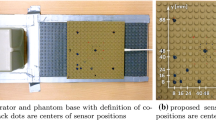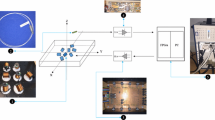Abstract
Electromagnetic tracking is currently the only available technology to track flexible instruments inside the human body without the use of real time imaging technology such as ultrasound or mobile c-arms. The limitation of electromagnetic tracking is its accuracy and sensibility to the environment, especially in the presences of ferromagnetic material and electronic devices. Navigation systems based on these technologies were recently introduced especially flexible endoscopy. One design goal for setting up such navigation systems is the removal of all material from the close environment that can perturb the magnetic field. In our scenario, within the radiation therapy room, we can not eliminate the gantry. Thus, existing methods for electromagnetic tracking error estimation and correction algorithms were reviewed, implemented, and adopted to the special requirement for navigation during prostate cancer treatment.
Access this chapter
Tax calculation will be finalised at checkout
Purchases are for personal use only
Preview
Unable to display preview. Download preview PDF.
Similar content being viewed by others
References
Guiraudon G, Moore J, Jones D, et al. Augmented reality for closed intracardiac interventions. In: International Workshop for Augmented Environments for Medical Imaging and Computer-aided Surgery (AMI-ARCS); 2006.
Hautmann H, Schneider A, Pinkau T, Peltz F, Feussner H. Electromagnetic catheter navigation during bronchoscopy: Validation of a novel method by conventional fluoroscopy. Chest 2005;128:382–387.
Solomon SB, Jr P White, Wiener CM, et al. Three-dimensional CT-guided bronchoscopy with a real-time electromagnetic position sensor: A comparison of two image registration methods. Chest 2000;118:1783–1787.
Livingston MA, State A. Magnetic tracker calibration for improved augmented reality registration. Presence: Teleoperators and Virtual Environments 1997;6(5):532–546.
Zachmann G. Distortion correction of magnetic fields for position tracking. In: Procs Computer Graphics International; 1997.
Ikits M, Brederson JD, Hansen C, Hollerbach J. An improved calibration framework for electromagnetic tracking devices. IEEE Virtual Reality 2001.
Kindratenko VV. A survey of electromagnetic position tracker calibration techniques. Virtual Reality: Research, Development, and Applications 2000;5(3):169–182.
Bryson ST. Measurement and calibration of static distortion of position data from 3D trackers. Procs SPIE 1992;1669:244–255.
Hardy RL. Multiquadric equations of topography and other irregular surfaces. J Geophys Res 1971;76:1905–1915.
Author information
Authors and Affiliations
Editor information
Editors and Affiliations
Rights and permissions
Copyright information
© 2007 Springer-Verlag Berlin Heidelberg
About this paper
Cite this paper
Traub, J., Kaur, S., Kneschaurek, P., Navab, N. (2007). Evaluation of Electromagnetic Error Correction Methods. In: Horsch, A., Deserno, T.M., Handels, H., Meinzer, HP., Tolxdorff, T. (eds) Bildverarbeitung für die Medizin 2007. Informatik aktuell. Springer, Berlin, Heidelberg. https://doi.org/10.1007/978-3-540-71091-2_73
Download citation
DOI: https://doi.org/10.1007/978-3-540-71091-2_73
Publisher Name: Springer, Berlin, Heidelberg
Print ISBN: 978-3-540-71090-5
Online ISBN: 978-3-540-71091-2
eBook Packages: Computer Science and Engineering (German Language)




